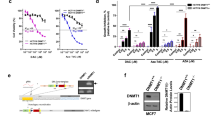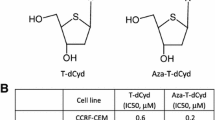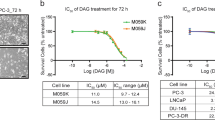Abstract
We investigated the ability of 5-(dimethyltriazeno)imidazole-4-carboxamide (DTIC, dacarbazine) and an analogue, temozolomide, to deplete cells or tumors of O6-alkylguanine-DNA alkyltransferase (AGT) and to enhance the antitumor effects of 1,3-bis(2-chloroethyl)-1-nitrosourea (BCNU). Human colon cancer (HT29) cell survival was decreased by almost 1 log when treated with 500 μM temozolomide prior to 150 μM BCNU. Administration of the maximal tolerated dose of DTIC (300 mg/kg) to nude mice carrying HT29 xenografts resulted in complete depletion of AGT activity in tumors at 4 h and 16 h. Administration of 150 mg/kg DTIC caused a 76% reduction in AGT activity at 4 h, but only a 28% reduction at 16 h. The maximally tolerated doses of DTIC and BCNU, alone and in combination, were used to treat nude mice bearing HT29 xenografts. No difference in tumor growth occurred when animals were treated with either BCNU alone (50 mg/kg), DTIC alone (300 mg/kg), DTIC (150 mg/kg) followed by BCNU (12.5 mg/kg), or BCNU (25 mg/kg) followed by DTIC (150 mg/kg). These data suggest that methylating agents such as DTIC may be too toxic to be used in combination with BCNU to deplete tumor alkyltransferase levels effectively and increase the therapeutic index of BCNU.
Similar content being viewed by others
References
Bradford MM (1976) A rapid and sensitive method for the quantitation of microgram quantities of protein utilizing the principle of protein-dye binding. Ann Biochem 72: 248–254
Brent TP (1984) Suppression of cross-link formation in chloroethyl-nitrosourea-treated DNA by an activity in extracts of human leukemic lymphoblasts. Cancer Res 44: 1887–1892
Catapano CV, Broggini M, Erba E, Ponti M, Mariani L, Citti L, et al (1987) In vitro and in vivo methazolastone-induced DNA damage and repair in L-1210 leukemia sensitive and resistant to chloroethyl-nitrosoureas. Cancer Res 47: 4884–4889
Daniel WW (1978) Applied non-parametric statistics. Houghton Mifflin, Boston
D'Incalci M, Citti L, Taverna P, Catapano CV (1988) Importance of the DNA repair enzyme O6-alkylguanine alkyltransferase (AT) in cancer chemotherapy. Cancer Treat Rev 15: 279–292
D'Incalci M, Taverna P, Erba E, Filippeschi S, Potenza D, Mariani L, et al (1991) O6-methylguanine and temozolomide can reverse the resistance to chloroethylnitrosoureas of a mouse L1210 leukemia. Anticancer Res 11: 115–122
Dolan ME, Young GS, Pegg AE (1986) Effect of O6-alkylguanine pretreatment on the sensitivity of human colon tumor cells to the cytotoxic effects of chloroethylating agents. Cancer Res 46: 4500–4504
Dolan ME, Moschel RC, Pegg AE (1990) Depletion of mammalian O6-alkylguanine-DNA alkyltransferase activity by O6-benzylguanine provides a means to evaluate the role of this protein in protection against carcinogenic and therapeutic alkylating agents. Proc Natl Acad Sci USA 87: 5368–5372
Dolan ME, Stine L, Mitchell RB, Moschel RC, Pegg AE (1990) Modulation of mammalian O6-alkylguanine-DNA alkyltransferase in vivo by O6-benzylguanine and its effect on the sensitivity of a human glioma tumor to 1-(2-chloroethyl)-3-(4-methylcyclohexyl)-1-nitrosourea. Cancer Commun 2: 371–377
Dolan ME, Mitchell RB, Mummert C, Moshel RC, Pegg AE (1991) Effect of O6-benzylguanine analogues on sensitivity of human tumor cells to the cytotoxic effects of alkylating agents. Cancer Res 51: 3367–3372
Domoradzki J, Pegg AE, Dolan ME, Maher VM, McCormick JJ (1984) Correlation between O6-methylguanine-DNA-methyl-transferase activity and resistance of human cells to the cytotoxic and mutagenic effect of N-methyl-N′-nitro-N-nitrosoguanidine. Carcino-genesis 5: 1641–1647
Erickson LC, Bradley MO, Ducore JM, Ewig RAG, Kohn KW (1980) DNA cross-linking and cytotoxicity in normal and transformed human cells treated with antitumor nitrosoureas. Proc Natl Acad Sci USA 77: 467–471
Futscher BW, Micetich KC, Barnes DM, Fisher RI, Erickson LC (1989) Inhibition of a specific DNA repair system and nitrosourea cytotoxicity in resistant human cancer cells. Cancer Commun 1: 65–73
Gerson SL (1989) Modulation of human lymphocyte O6-alkylguanine-DNA alkyltransferase by streptozotocin in vivo. Cancer Res 49: 3134–3138
Gerson SL, Trey JE, Miller K (1988) Potentiation of nitrosourea cytotoxicity in human leukemic cells by inactivation of O6-alkylguanine-DNA alkyltransferase. Cancer Res 48: 1521–1527
Gibson NW, Hartley J, La France RJ, Vaughan K (1986) Differential cytotoxicity and DNA-damaging effects produced in human cells of the Mer+ and Mer− phenotypes by a series of alkyltriazenylimidazoles. Carcinogenesis 7: 259–265
Gonzaga PE, Potter PM, Rafferty JA, Niu T, Margison GM, Ludlum DB, et al (1992) Structure of the guanine-cysteine linkage formed between BCNU-treated DNA and human O6-methylguanine-DNA methyltransferase. Proc Am Assoc Cancer Res 33: 548
Hansen MB, Nielsen SE, Berg K (1989) Re-examination and further development of a precise and rapid dye method for measuring cell growth/cell kill. J Immunol Methods 119: 203–210
Karran P (1985) Possible depletion of a DNA repair enzyme in human lymphoma cells by subversive repair. Proc Natl Acad Sci 82: 5285–5289
Kohn KW (1977) Interstrand cross-linking of DNA by 1,3-bis(2-chloroethyl)-1-nitrosourea and other 1-(2-haloethyl)-1-nitrosoureas. Cancer Res 42: 1450–1454
Lee DM, Thatcher N, Margison GP (1991) O6-alkylguanine-DNA alkyltransferase depletion and regeneration in human peripheral lymphocytes following dacarbazine and fotemustine. Cancer Res 51: 619–623
Lunn JM, Harris AL (1988) Cytotoxicity of 5-(3-methyl-1-triazeno)imidazole-4-carboxamide (MTIC) on Mer+, Mer+ Rem− and Mer−-cell lines: differential potentiation by 3-acetamidobenzamide. Br J Cancer 57: 54–58
Mastrangelo MJ, Bellet RE, Kane MJ, Berd D (1992) Chemotherapy of melanoma. In: Perry MC (ed) The chemotherapy source book. Williams and Wilkins, Baltimore
Meer L, Schold SC, Kleihues P (1989) Inhibition of the hepatic O6-alkylguanine-DNA alkyltransferase in vivo by pretreatment with antineoplastic agents. Biochem Pharmacol 38: 929–934
Micetich KC, Futscher B, Koch D, Fisher RI, Erickson LC (1992) Phase I study of streptozocin- and carmustine-sequenced administration in patients with advanced cancer. J Natl Cancer Inst 84: 256–260
Mitchell EP, Schein PS (1992) Nitrosoureas. In: Perry MC (eds) The chemotherapy source book. Williams and Wilkins, Baltimore
Mitchell RB, Moschel RC, Dolan ME (1992) Effect of O6-benzylguanine on the sensitivity of human tumor xenografts to 1,3-bis(2-chloroethyl)-1-nitrosourea and on DNA interstrand cross-link formation. Cancer Res 52: 1171–1175
Panella TJ, Smith DC, Schold SC, Rogers MP, Winer EP, Fine RL, et al (1992) Modulation of O6-alkylguanine-DNA alkyltransferase-mediated carmustine resistance using streptozotocin: a phase I trial. Cancer Res 52: 2456–2459
Pegg AE (1990) Mammalian O6-alkylguanine-DNA alkyltransferase: regulation and importance in response to alkylating carcinogenesis and therapeutic agents. Cancer Res 50: 6119–6129
Pegg AE, Wiest L, Mummert C, Stine L, Moschel RC, Dolan ME (1991) Use of antibodies to human O6-alkylguanine-DNA alkyltransferase to study the content of this protein in cells treated with O6-benzylguanine or N-methyl-N′-nitro-N-nitrosoguanidine. Carcinogenesis 12: 1679–1683
Pieper RO, Futscher BW, Dong Q, Erickson LC (1991) Effects of Streptozotocin/bis-chloroethylnitrosourea combination therapy on O6-methylguanine DNA methyltransferase activity and mRNA levels in HT-29 cells in vitro. Cancer Res 51: 1581–1585
Robins P, Harris AL, Goldsmith I, Lindahl T (1983) Cross-linking of DNA induced by chloroethylnitrosourea is prevented by O6-methylguanine-DNA methyltransferase. Nucleic Acids Res 11: 7743–7758
Skipper HE (1974) Combination therapy: some concepts and results. Cancer Chemother Rep 4: 137–145
Yarosh DB, Hurst Calderone S, Babich MA, Day RS (1986) Inactivation of O6-methylguanine-DNA methyltransferase and sensitization of human tumor cells to killing by chloroethylnitrosourea by O6-methylguanine as a free base. Cancer Res 46: 1663–1668
Zeller WJ, Berger MR, Weber E (1986) More than additive toxicity of the combination of 1-methyl-1-nitrosourea plus 1,3-bis(2-chloroethyl)-1-nitrosourea in the rat. Cancer Res 46: 1714–1716
Author information
Authors and Affiliations
Additional information
This work was supported by National Institutes of Health Grants CA-47228 (M.E.D.) and 5T32-DK-07134 (R.B.M.).
Rights and permissions
About this article
Cite this article
Brian Mitchell, R., Eileen Dolan, M. Effect of temozolomide and dacarbazine on O6-alkylguanine-DNA alkyltransferase activity and sensitivity of human tumor cells and xenografts to 1,3-bis(2-chloroethyl)-1-nitrosourea. Cancer Chemother. Pharmacol. 32, 59–63 (1993). https://doi.org/10.1007/BF00685877
Received:
Accepted:
Issue Date:
DOI: https://doi.org/10.1007/BF00685877




